Draisine R (1933)
 Poland Dreyzina R, 23 built 1931-39
Poland Dreyzina R, 23 built 1931-39
Historical Context
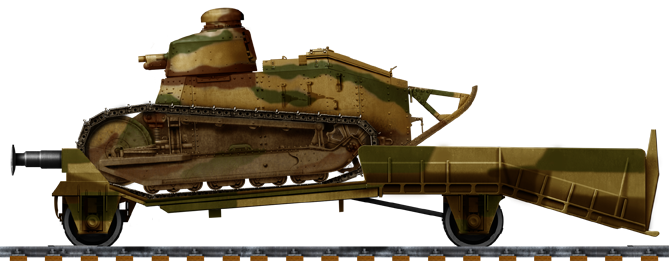
The "draisine" (Polish: drezyna) is still a reality today, but no longer in the military sense, to inspect the railways and its infrastructure. But back in the interwar, these were light auxiliary rail motor cars foing reconnaissance in advance or after a train. Much simpler and smaller, using a common petrol/diesel engine, it was able to perform this job with little notice, unlike a train which steam engine needed time to heat up and build pressure. The ideaz was not new: See Simm's armoured draisine of 1901.
Poland in 1919 saw quickly the advantages of using armoured trains in general, but also the usefulness of Armoured draisines ("drezyna pancerna") in the Polish-Soviet war with or without integrations into armoured trains. The army already used light trains for this task. Until then the only example has been Sims models back in 1899. The obvious solution was to convert an armoured car for rail. But they were hardly easily convertible. Detached, partially armoured locomotives were not ideal given the time they needed to get ready. Small armoured draisines using their own patrol engine were preferrable and procurement started with the Czech-Polish Tatra models in the 1920s. However the the T-18 proved underpowered and lightly armed in case of a bad encounter.
Another solution that was studied were the draisines R and later TK, essentially modifield flatbed carriages that could be powered by the armoured vehicles they carried, and in that case, tanks. This was a novel solution which presented a set of advantages. They had an advantage over "pure" armoured draisines, as they were capable of detaching and venture out the tracks in the surrounding to extend their mission's range. For these, a tactical concept was even created, the Draisine platoons, taking part in the fierce fights of September 1940.
Design

Draisine R alone on tracks, from pinterest.ru, wrongly labelled with tank "FT 18"
After the disappointment of the Tatra T-18, Colonel Tadeusz Kossakowski (Engineering Department) proposed to the general staff in 1931 to "recycle" the now aging Renault FT from 1919 into an armoured draisine, providing it was given a tailored rail chassis. Design was started at the Military Engineers Research Institute. What was completely new as a concept, circumventing the drawbacks of the T18, was the power source: It was to come directly from the tank itself. That means the "draisine" was unpowered by itself, but thus simpler to manufacture and maintain, and cheaper. The otrher advantage of this coupling was the tank could be detached and provided outer reconnaissance. In the end, this was also a way to recycle the old Renault FTs in a useful way. The program was approved as the "medium rail-and-ground armoured draisine "R" the letter standing for the tank's manufacturer, Renault.
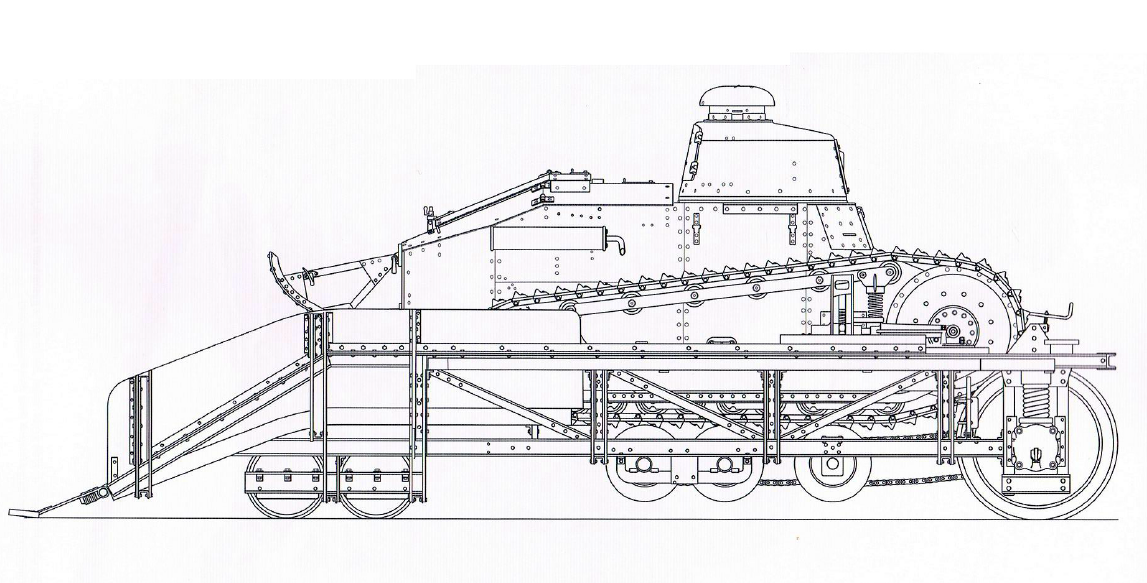
Draisine R prototype in 1933 src
Since the only difficulty was to find a way to "plug-in" the power shaft of the tank engine to the axles, and another, simpler way was found. A first prototype was ready by 1932, provided by the 1st Armoured Train Unit, Legionowo. In this system, the tank's tracks provided power through special rollers/transmission but this was complicated and quickly worn out the engine's own transmission. Still, it was capable of propelling the whole ensemble to 38 km/h (23.6 mph), so far more than the actual tank itself...
In 1933 another prototype was tested: It had this time the main axles driven directly by the engine, this time using a reliable drive shaft designed by the institute. The mechanical gear was manufactured however at Warsaw's Lilpop, Rau and Loewenstein works. It was successful, proviuding the Draisine a top speed of 45 km/h (28 mph). it was almost thrice as fast as the original tank, albeit still on the slow side compared to most locomotives.
But the army considered this a success and ordered three more chassis the next year. More modifications and iron out defaults led to a favourable report and vote fort an order in January 1938 of 18 Drezyzina R chassis, to be manufactured by Wspólnota Interesów Works in Chrzanów (Southern Poland). They were then to be distributed to two armoured Trains Units and by 1939, 38 of such Draisine R chassis were avilable at unit cost of 12.400 złoty which appeared low enough to make the whole enterprise worth it.
Power System

The original FT in combat with doughboys, 1918, colorized (pinterest)
The useful part of the whole design, which was essentIally a modified flatbed car supporting the tank, was the special drive shaft that came out from the gearbox and needed to modify the side clutches, radiator fan of the Renault powerplant. The rail chassis itself was welded, weighted 3.4 t. for a total lenght overall of 8.11 meters, by 2.04 meters long, 2.83 meters in height with the tank or 319.3 inches, 80.3 inches in lenght and width and 111.4 inches tall, while gaving an axle span on 4.75 meters or 187 in inches. Its tractive capacity was 25 tons, so way more than the FT tank itself. Fully loaded, comprising the tank, the Draisine R weighted 10.5 tonnes to 11 tonnes.
Polish engineers managed to used a two ramps system at a rear, laying on flat springs as well as folding upwards. To enter the chassis, the FT had to ride into it and after being secured in place, the crew opened the engine compartment and connected the drive shaft to the chassis own drive gear. Below the tracks there was a, hydraulic system activated with a hand pump in order to actively support the tank bottom via a central beam frame. Most amazing is that whole 'mounting' spanned only five minutes. Dismounting was even easier, made in three minutes. It needed to have the tank lifted by the hydraulic jack onto the ramps in order to ride the chassis out.
Armament & protection
The armament and protections were of course offered by the tank itself, which also provided power to the empty chassis. The FT tank, and by prolongation the full draisine thus had a crew of two, driver and gunner, standing behind in the small one-man turret. The driver moslty had it's forward twin hatch entry closed in combat, opened the reast of time for aeration and better sight. The tank itself wehited 6.7 tonnes.The armament was the same as the originally delivered "char canon" variant of the FT: A single 37 mm SA-18 (wz.18) Puteaux L/21 gun managed by the commander. Meaning he had to see around via the above mushroom, pick a target, point the gun through the side, fire and reload it. But also giving instruction to the driver, generaly by kicking his head for basic directions and a stop, as the engine sound was defeaning. The FT was protected ahainst heavy machine guns with 16 mm in front, 8 mm on the rear and above plates, bottom, and 22 mm for the cast gun turret, the chassis left unarmoured or "soft skinned".
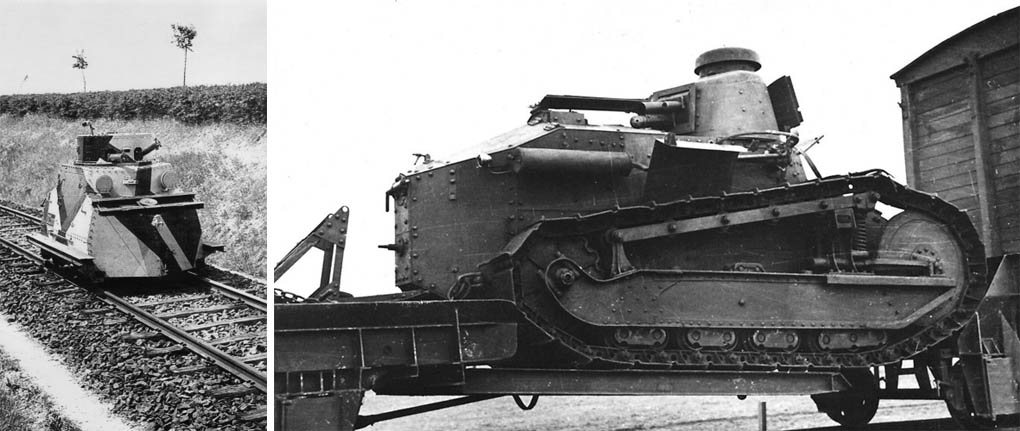
Draisine Tatra T18 (left) and Draisine R showing the FT tank resting on beams. src
Performances
The Draisine R had the FT engine, mezning the puny Renault gasoline 4-stroke, 4-cylinder inline power unit rated for a capacity of 4,480 ccm and delivering 35-39 HP at 1,500 rpm. It was water cooled and the fuel tanjs carried, combined 95 liters. Which gave 45 km/h in top speed, and in the right conditions, up to 55-57 km/h for the better geared, improved later series, which was superior to all existing tanks on the battlefield at the time (apart the Soviet BT series).The chassis could use a reversing gear to run backwards with the same panel of speeds as forward, quite handy for a one-way railway. The chassis was provided with standard buffers and coupling to be mated to any locomotove or railway car, or even push/pull some if needed. A composite Draisine R thus could have an auxiliary railcar with supplies or a cabin for the crew to rest and extra troops if needed, although it was never implemented. It must be also said that the tank sat relatively low on its chassis for stability, and the turret would be obstructed by tall wagons.
When riding backwards, the driver was instructed by the commander turned backward, seeing through its small turret cupola. Sinnce braking was no longer provided by the tank itself, the chassis came with two crank-operated mechanical brakes, only on the forward axle. Its modus operandi is unknown. Also, no provision was given to provided electricity to anny applia,ces like signal lights or a projector. They were absent. In 1936 though, the draisoins came with a battery mounted on the left side, external, to feed signal lights and adding an external electric starter to replace the original engine's hand crank. It's possibnle these modifications were retroactively applied.
Draysina R class specs | |
| Dimensions (L-W-H) | 8.11 x 2.04 x 2.83 m |
| Weight | 10.5 total, 3.4t carriage, 6.7 tonnes tank |
| Power | Renault gas. 4-str, 4-cyl. 4480 ccm 35-39 HP |
| Performances | 7.8 km/h (4.9 mph) |
| Crew | 2: Tank cdr/gunner, driver |
| Armament | 37 mm Puteaux SA-1817 |
| Armor | As the original tank, 7 mm, carriage unprotected. |
Polish Draisine Platoons
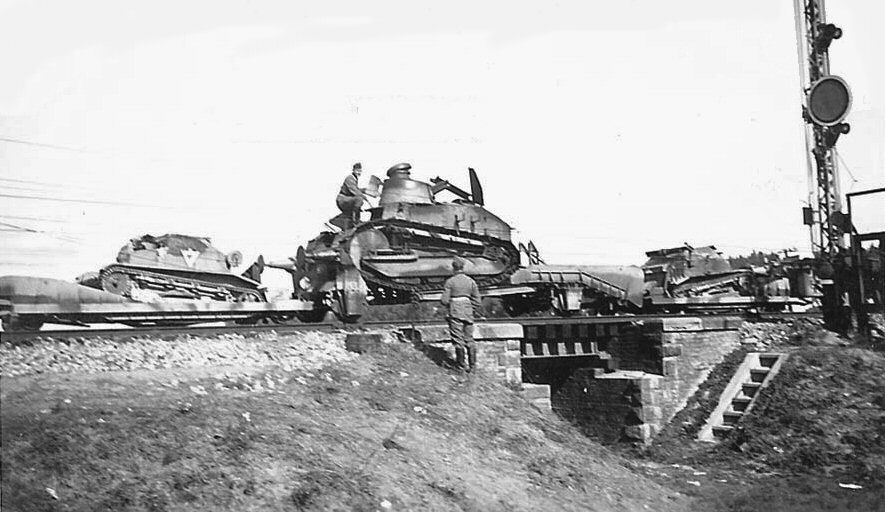
Draisin platoon "TK-R-TK" (pibwl)
The Polish army staff managed to have each registered Armoured train mobilized in 1939 provision of two Draisines R, with the exception of Nr. 15 ("Śmierć") which had two Tatras. Each was came a "platoon", when completed by four light armoured draisines, TK or TKS (which featured Polish TK/TKS tankettes instead). They were detached en route to patrol forward or behind and ulike the Tatra T18 draisines, provided outer reconnaissance around the railway as well. This proved at least on paper quite handy. The R were considered "medium" armoured draisines and part of each platoon also had a fifth reserve tankette laying on a flatcar. Fiven the numbers, they operate often as a trio called "TK-R-TK" the medium FT tank draisine being on the middle. Its entire crew totalled 17 commanded by one officer and six NCO/gunners plus 10 drivers, 12 crew total and 4 NCOs officers and one platoon sergeant.
In 1936 they came out camouflaged, a standard tricolor scheme in greyish sand, dark brown, brown-green (base) in irregular airbushed patches roughly in formed rectangles but with other motives. Some photos shows older ones wearing their 1920 4-color camouflage separated by black outlines, but on tankettes. The main issue with these Draisins was a lack of radio with one draisine R tested as such, featuring a larger battery and new electric wiring. The TK-R-TK (both end of the train) combo provided a 37 mm gun and two Vz.25 (Hotchkiss) MGs but the tankettes had it in ball mounts, with limited field of fire.
Captured Draisine R (src)
In combat, nothing went according to plan and the draisines were used in unplanned manners most of the time, like for train Nr. 13 which sent both its draisines to defend a bridge in Tczew, both destroyed and replaced. They took part before this to an improvised platoon as part of the 1st Armoured Train Unit at Legionowo. One draising was part of the 2nd Armoured Train Unit later allegedly destroyed near Jarosław. Nr. 13 ("Generał Sosnkowski") was constituted when destroyed by two Tatras, two draisines R. Its former ones were sent to Pomorze and the defense of Dirschau while the other armoured trains operating had the "on paper" composition. All these draisines were lost in action, but likely recuperated and likely recycled into standard railcars by the Germans or Soviet during WW2.
Gallery

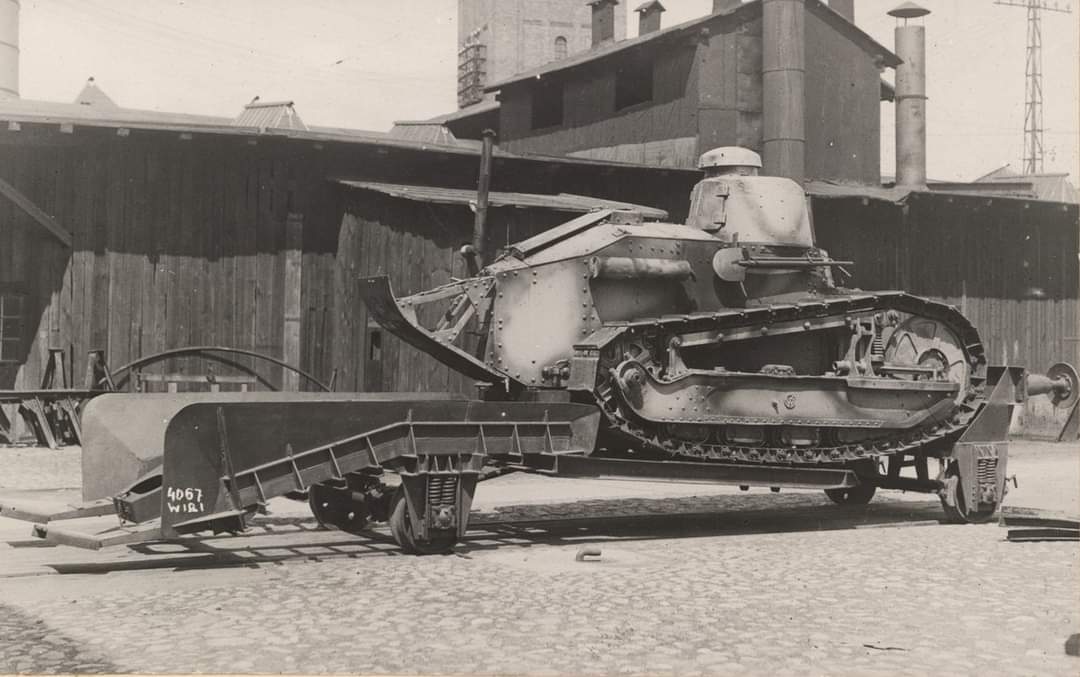
Draisine R, factory photo (from twitter)

src cdn2.picryl.com, wikimedia cc
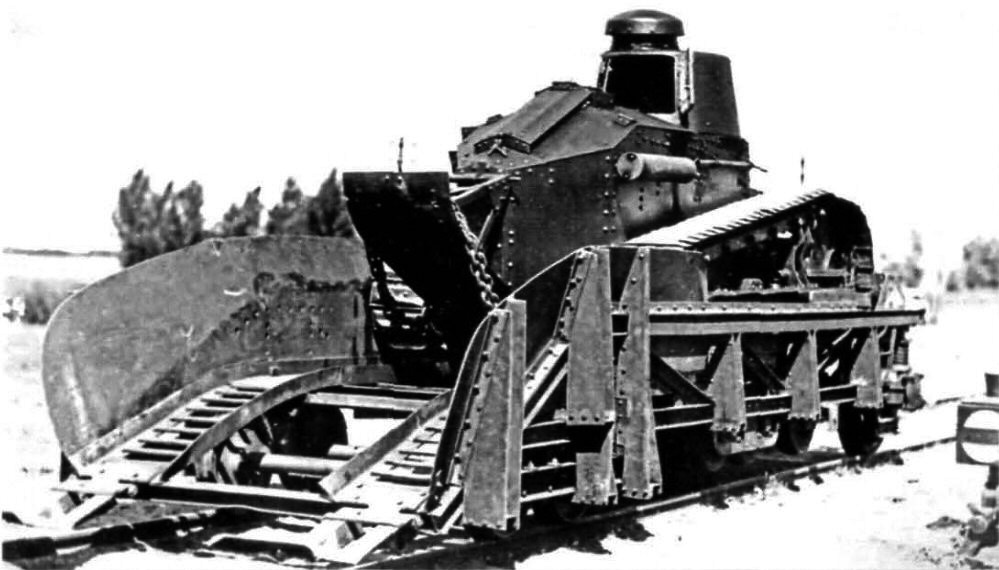
Rear of a draisine (pibwl)
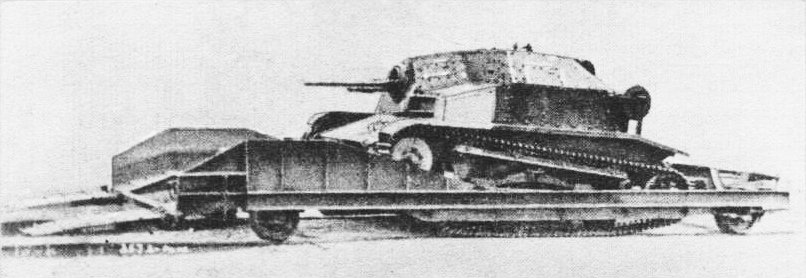
Dreyzina Pancerna Typu TKS
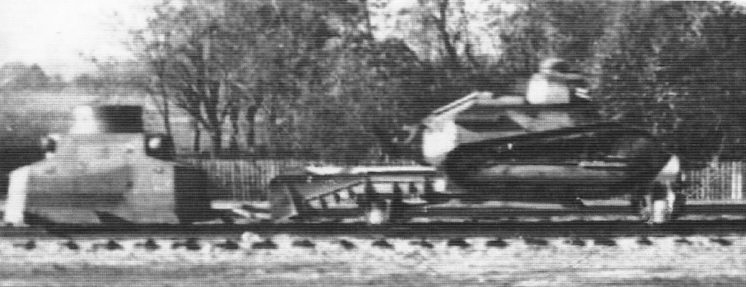
Dreyzina R on "General Sonowski" N°13 train with a Tatra T18 (src below)
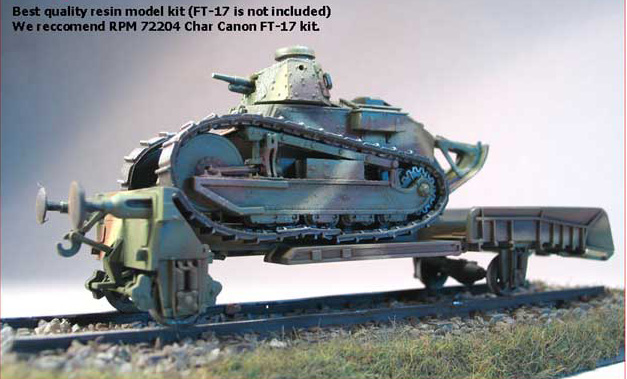
model kit
Sources
derela.pl
dieselfutures.tumblr.com
derela.pl orig. article
dzen.ru - The first modern tank. Part 23.2. Drezyna pancerna typu "R". 1932-1933. Tanks on rails
darkroastedblend.com
reddit.com
szczurforteczny.pl/
On scalemates.com
- Baldwin Railroad battery 1861
- No 6 Garrison Arm. Train 1894
- Ladysmith Train 1899
- Crewe Works 1915 coastal train
- French mobile artillery battery (1914)
- Royal Navy armoured Train 1914
- Regia Marina Arm. Trains 1915-18
- Ajmer arm. trains 1916
- Hungarian MAVAG train
- German Panzerzug Ost (1916)
- Bolshevik Armored Tram 1917
- Finnish Arm. Train (1918)
- Zaamurets (Orlík, BP-4, Lenin)
- Khunkhuz
- General Annenkov
- Yenisei
- Amur
- Terek
- Don
- Dywizja Syberyjska trains 1918
- Kozak
- Piłsudczyk
- PP3
- Gromobój
- Pionier
- Śmiały
- Lis-Kula
- Hallerczyk
- Stefan Batory
- Generał Iwaszkiewicz
- Chrobry
- Wilk
- Danuta
- Poznańczyk
- Kaniów
- Zawisza Czarny
- Zagończyk
- Paderewski
- Mściciel
- Reduta Ordona
- Huragan
- Podhalanin
- Bartosz Głowacki
- Pierwszy Marszałek
- Groźny
- Śmierć
- Śmigły
- Stefan Czarniecki
- Generał Sosnkowski
- Putilov armoured trains
- Izhorskiy Armored Train
- Czechoslovak Legion Trains
- Estonian Trains
- Lithuanian Trains
- Zhang Zongchang Train
- Danuta
- Poznańczyk
- Generał Sosnkowski
- Paderewski
- Śmierć
- Pierwszy Marszałek
- Piłsudczyk
- Śmiały
- Groźny
- Bartosz Głowacki
- Smok Kaszubski
- Drezyna R
- Drezyna TK/TKS
- UK dywizjon Trains
- SOK Draisines 1945
- Arm. draisine Crochat
- Austro-Daimler Draisine
- Armoured draisine Tatra T18
- MBV-2 Rail cruiser
- D-2 Draisine (MBV-31)
- D-37 Draisines
- Krasnaja Zvezda (KZ-1)
- D-3 Draisines
- BTD heavy Draisines (5)
- CB-1 Draisines
- DT-45 Draisines
- BD-41 Draisines (12)
- BA-I-Zhd Railcar
- BA-6ZhD Railcar
- BA-20ZhD Railcar
- BA-10Zhd Railcar
- VS-60 Train/Wagon
- BP-35L/H Train
- NKPS-42/Wagon Train (40)
- PL-35 Arty Wagon
- PL-37 Arty Wagon
- PT-35 Arty Wagon
- KV-1 Arty Wagon
- Crimean 76mm univ. Wagon
- "Tank" Wagon
- BP-42 Train/PL-42 Wagon (10)
- BP-43 Train/Wagon (54)
- 7.62mm Maxim SPU-BP Flak wagon (28)
- 37mm PVO-4 FLAK Wagon (120)
- OB-3 Light Wagon
- 27th Div armoured Trains
- 29th Div armoured Trains
- 48th Arm. Div armoured Trains
- "Stalinets" armoured Train
- "Mir Jafar Bagirov" armoured Train
- "Kozma Minin" armoured Train
- "Dzerzhinets" armoured Train
- "Za Rodinu!" armoured Train
- "Kolomensky Rabochy" armoured Train
- Zenitnyy (AA) armoured Trains
- Goering's Asien
- BP42 armoured train (full)
- BP44 armoured train (full)
- Panzerjägerwagen BP44
- BR 52, Steyr Schwerer Schienen Panzer
- Schwerer gustav Train
- P204(f) rail tank
- Schienenkampfwagen SK 1
- Schwerer Spähzug (s.Sp.) Artilleriewagen
- LeichteSchienenkampfwagen 43
- Zeppelin Panzer Draisine
- Panzertriebwagen N17
- Panzertriebwagen N16
- Panzer Draisine Funkwagen
- Panzerdraisine/Pz.III turm
- Panzerdraisine/Pz.IV turm
- Panzer Draisine Le.Sp.
- Panzer Draisine Flakvierling
- S.Panzer Draisine Kugelblitz
- L2670 leichtes panzertriebwagen
- AB Ferroviana
- Littorina OM 36
- LiBli 42
- Type K2 Steam Locomotive No.134
- Type C56 Steam Locomotive No.31
- Type 90 240 mm Railway Cannon (Futtsu Cannon)
- Type 91 Broad-gauge Railroad Tractor (So-Mo)
- Type 94 Armoured Train
- Type 95 Armoured Railroad Car (So-Ki)
- Type 98 Railroad Tractor
- Type 100 Railroad Tractor
- Type 2598 Railroad Car
- Rinji Soko Ressha 1933
- 1940 coastal defence Trains
- Royal Armoured Corps Trains
- Romney, Hythe and Dymchurch Train
- Malaya Arm. train 1942
- 101-104. sz. páncélvonat
- Finnish Winter War Train
- Croatian Armored Train
- Can. Aleutian No.1 Armoured Train
- Slovak resistance armoured train
- Iraqi armoured train (1941)
- Polish 1945-55 trains
- Arm. train La Rafale 1948
- Tren Blindado 1958
- Panser Rel V16 (1955)
- White Train 1957-87
- RT-23 Molodets ballistic wagon
- Trans-Siberian Arm. Train 1970
- North Korean Arm. Train
- Krajina express 1990
- Volga (2022)
- Baikal (2022)
19th Cent. Trains
WW1 Armored Trains
 Poland
Poland
Interwar Armored Trains
WW2 Armored Trains
 France
France
 Austria
Austria
 Czechoslovakia
Czechoslovakia
 USSR
USSR
 Nazi Germany
Nazi Germany
 Italy
Italy
 IJA
IJA
 UK
UK
 Others
Others
☢ Cold war Armored Trains
References
blog.railwaymuseum.org.ukarmedconflicts.com Russian Trains
warhistoryonline.com
feldgrau.com ww2 german trains
cuttersguide.com
wikipedia.org/wiki/Armoured_trains_of_Poland
derela.pl/drais
derela.pl/tatra.htm